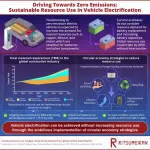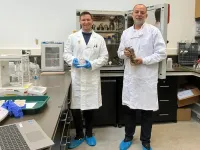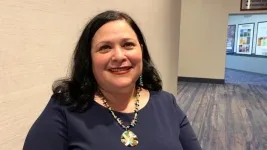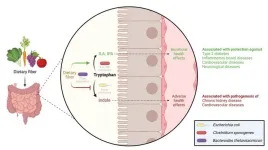(Press-News.org) ASAP Launches Data-Sharing Tool with Unique Dataset of Human Postmortem-Derived Brain Samples
Aligning Science Across Parkinson’s (ASAP) launched a platform to make high-value data for Parkinson’s disease broadly available to researchers all over the world
The platform launches with data from a unique human postmortem-derived brain sequencing collection, including samples from four ASAP Collaborative Research Network (CRN) teams and 156 donors
The database will continue to expand, with 629 donors contributing to the final harmonized dataset; there will be a consistent cadence of new data releases
CHEVY CHASE, MD (JUNE 25, 2024) The Aligning Science Across Parkinson’s (ASAP) initiative has launched the ASAP CRN Cloud, a data-sharing tool designed to advance Parkinson’s disease (PD) research by making data easily available to researchers worldwide. This new platform launches with a high-value dataset of human postmortem-derived brain samples, offering unprecedented insights into neurodegeneration. The dataset features samples from four CRN teams worldwide and 156 donors, with 629 donors contributing to the final harmonized dataset.
The CRN Cloud brings resources from across ASAP’s network to a single platform, enabling researchers to share, access, and work directly with other leading experts to distill discoveries offering the potential for unprecedented insights into neurodegeneration. The initial data originates from ASAP’s Collaborative Research Network, an international, multidisciplinary, and multi-institutional network of scientists working to address high-priority basic science questions at the heart of PD.
“Human postmortem-derived brain samples and data are a precious resource that are highly limited for scientific research communities studying neurodegenerative diseases like Parkinson’s disease,” said Sonya Dumanis, PhD, deputy director at Aligning Science Across Parkinson’s (ASAP). “By democratizing and federating data in one place through the CRN Cloud, ASAP and our partners are building responsible, open access data and resources to amplify the impact of every contribution across the research community and allow researchers to develop faster and better outcomes.”
The launch collection of human postmortem derived brain samples contains single-cell transcriptomic data. Single-cell transcriptomics allow each cell to be independently characterized and scrutinized for which genes are active or “expressed” in each cell type to better understand what goes wrong in neurodegeneration. This approach has already provided critical insight in many diseases, including cancer, where the ability to study adjacent cancerous and healthy cells has provided new insights into how cells go awry, and how they can be detected or targeted. This approach is highly anticipated in the field of neuroscience, where the brain’s diverse cell types, complex structures and subtleties of pathology can only be observed after death.
ASAP developed the tool with implementation partner The Michael J. Fox Foundation for Parkinson’s Research, along with technical partners at DataTecnica, DNAstack, and Verily.
DataTecnica’s technology contributes to analysis from pre-processing to annotation, ensuring datasets are harmonized and high-quality.
DNAstack provided a data platform which allows for data to be stored securely within a cloud environment while still being accessible to the broader research network – a technique called data federation.
Verily Viewpoint Workbench creates a collaborative environment where scientists worldwide can access, analyze, and share data. Combining the data, governance, and analytic resources in a globally shared platform democratizes the data, enabling and empowering a vibrant global research community unconstrained by local resources.
Researchers who are interested in accessing the data should visit https://cloud.parkinsonsroadmap.org and submit a Data Use Application from within the platform. To submit an application, researchers need to provide their role, institution, and intended use of the data, as well as agree to the terms of the data use agreement. Once data access has been granted, researchers will have access to all data sets.
From the transcriptomic data of a single brain cell to the massive, federated data network, ASAP continues to bring information and partners together in service of reducing barriers to data access and advancing Parkinson’s research.
For more information, please contact:
Media Contact:
Rosanna Vierra, GMMB
rosanna.vierra@gmmb.com
808.215.1173
###
About Aligning Science Across Parkinson’s Disease (ASAP)
The Aligning Science Across Parkinson’s (ASAP) initiative is a coordinated research initiative to advance targeted basic research for Parkinson’s disease. ASAP is devoted to accelerating the pace of discovery and informing the path to a cure for Parkinson’s disease through collaboration, research-enabling resources, and data sharing. Led by Nobel Laureate Dr. Randy Schekman and Dr. Ekemini Riley, ASAP is managed by the Coalition for Aligning Science and is working with The Michael J. Fox Foundation to implement its programs. The initiative was incubated at the Milken Institute Center for Strategic Philanthropy with support from the Sergey Brin Family Foundation. For more information, visit us at www.parkinsonsroadmap.org or on LinkedIn.
END
In 2018, Arthur Ashkin won the Nobel Prize in Physics for inventing optical tweezers: laser beams that can be used to manipulate microscopic particles. While useful for many biological applications, optical tweezers require extremely controlled, static conditions to work properly.
“Optical tweezers work by creating a light ‘hotspot’ to trap particles, like a ball falling into a hole. But if there are other objects in the vicinity, this hole is difficult to create and move around,” says Romain Fleury, head of the Laboratory of Wave Engineering in EPFL’s School ...
With goals to limit CO2 emissions, many countries have set targets to phase out internal combustion vehicles in favor of electric vehicles (EVs). Japan has set a target for 20-30% of all car sales to be battery electric vehicles (BEVs) and plug-in hybrid electric vehicles (PHEVs), and 30-40% of car sales to be hybrid electric vehicles (HEVs) by 2030. The USA plans for 50% of new vehicles to be zero-emission by 2030, while Germany wants to have 15 million EVs on the road by 2030. These goals raise concerns about the raw material demand for EVs. Batteries, which account for 50% of all resources consumed in BEV production, require ...
Trying to figure out whether someone has Alzheimer’s disease usually involves a battery of assessments—interviews, brain imaging, blood and cerebrospinal fluid tests. But, by then, it’s probably already too late: memories have started slipping away, long established personality traits have begun subtly shifting. If caught early, new pioneering treatments can slow the disease’s remorseless progression, but there’s no surefire way to predict who will develop the dementia associated with Alzheimer’s.
Now, Boston University researchers say they have designed a promising new artificial ...
If aliens modified a planet in their solar system to make it warmer, we’d be able to tell. A new UC Riverside study identifies the artificial greenhouse gases that would be giveaways of a terraformed planet.
A terraformed planet has been artificially made hospitable for life. The gases described in the study would be detectable even at relatively low concentrations in the atmospheres of planets outside our solar system using existing technology. This could include the James Webb Space Telescope, or a future European-led space telescope concept.
And ...
Researchers from Trinity College Dublin’s School of Natural Sciences have revealed a novel route to the formation of bastnäsite, a crucial mineral for the extraction of rare earth elements (REEs). Their work offers promise in one day making the extraction of these REEs more efficient.
The study – published today in the journal Nanoscale – uncovers for first time how fluocerite, a rare mineral, quickly forms and transforms into bastnäsite. The occurrence and origin of fluocerite in natural deposits was not fully understood, ...
ALBUQUERQUE, N.M. — The Department of Energy has once again awarded Sandia National Laboratories for its work helping small businesses. One of those businesses, owned by a disabled veteran, was also awarded for its extraordinary work.
DOE Mentor of the Year
Sandia’s small business Mentor-Protégé Program has been named as DOE Mentor of the year, an award it has received for three consecutive years.
Now in its fifth year, the program has mentored five protégés from around the country. More than 150 volunteer mentors and support personnel help these small and disadvantaged businesses grow, succeed and navigate doing business ...
PULLMAN, Wash. – Your mom might be a better health influencer than Dwayne “The Rock” Johnson.
Adults in a study who said they looked to a person they knew as role model for good health—such as a friend, relative or healthcare provider—rather than a celebrity, had greater motivation to reach their health goals. The women participants were also more likely than men to choose a personal role model rather than a celebrity. And the person most often named was their own mother.
“We know that parents have a huge influence on shaping people’s health trajectories throughout their life just ...
Giant lizards called heath goannas could save Australian sheep farmers millions of dollars a year by keeping blowfly numbers down - and must be prioritised in conservation schemes to boost native wildlife, say researchers.
A study led by the University of Cambridge has found that heath goannas - a species of giant, scavenging lizard - act as natural clean-up crews by clearing maggot-ridden animal carcasses from the landscape.
This reduces the emergence of blowflies, which attack sheep by laying eggs on their backsides that hatch into flesh-eating maggots. The disease, known as ‘fly strike’, costs the Australian sheep farming industry an estimated $280 million a year.
This ...
This process is currently not included in models that predict sea level rise, so the new results could offer a more accurate picture of how the world will change with global warming and how much coastal areas will need to adapt.
Carried out by scientists at the British Antarctic Survey (BAS), the findings are published in the journal Nature Geoscience.
“We have identified the possibility of a new tipping-point in Antarctic ice sheet melting,” says Alex Bradley, an ice dynamics researcher ...
We get healthy dietary fibres from consuming fruits, vegetables, and whole grains. But why are the fibres so good for us? A team of researchers has discovered that dietary fibres play a crucial role in determining the balance between the production of healthy and harmful substances by influencing the behaviour of bacteria in the colon.
Dietary fibres benefit our health, and scientists from DTU National Food Institute and the Department of Nutrition, Exercise and Sports at the University of Copenhagen have now uncovered an essential part of why this is the case. Different types of bacteria inside our colon compete to utilize an essential amino acid called tryptophan. This competition ...






